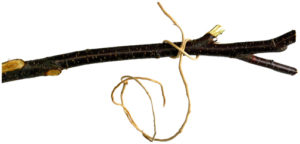 The story I’m about tell goes back to the sixties, the early days of my life. The information is a tribute to my Elders, relatives, friends, and native and non-native anglers. Most of the information was obtained through traditional knowledge and Elder Dr. Albert Marshall through his concept of two-eyed seeing.
The story I’m about tell goes back to the sixties, the early days of my life. The information is a tribute to my Elders, relatives, friends, and native and non-native anglers. Most of the information was obtained through traditional knowledge and Elder Dr. Albert Marshall through his concept of two-eyed seeing.
Growing up, I listened to stories my father’s friends would tell in the kitchen waiting for their turn to get a hair-cut from my father. Sometimes I would get in trouble for asking questions and being nosy. I don’t know how many times I was told to mind my own business and stay out of the way. Of course I would find ways to listen in on their stories, hiding behind the couch or stove. I always kept my ears open to the ways of harvesting plamo (salmon).
In this story I look at snaring the old-fashioned, hard way. Basically it boils down to the newer way of using an eel spearing pole and a coil of rabbit snare. The old fashioned way is using a twelve foot piece of straight tubis (alder), and a tree root, which I don’t know the name of to this day .
The other part of my story is about Qamsipuk (Indian Brook) where it runs through Eskasoni where the old iron bridge used to be, later replaced by a new road and bridge. My story begins at the lower end of the river where there used to be two pools–one was called Temikewey (Deep Pool) and the other was called A’qatitemikewey (Half Deep Pool). When I look at the river now I see it has changed a lot! The pools are gone,washed away by ice and erosion or, in my opinion, due to the new road and bridge.
As my story begins, my Grandmother Bridget Joe instructed my uncle, Ekkian Dennis, to fish for salmon in Quesepul. It was a beautiful fall day. We thought that the salmon run was around October 15– “every year the early run” the Elders would say.
As we set off we stopped at Sylliboy’s Grocery, it was called Ben’ek, our local supply store. We purchased a roll of rabbit snare wire and there were curious looks from the patrons inside the store. No questions were asked why we purchased snare wire, guess they were wondering because it was too early for rabbits. We were off to Qamsipuk and soon we got to A’qatitemikewey. As we approached our spot there lay a beautiful salmon in the pool; the water was crystal clear in the sun’s glare. The salmon was laying there with his tail just moving, trying so hard not to be noticed. You think it looks too relaxed, leave it alone, but all we can think of was my Grandmothers words, “it would be nice day for a salmon meal.” Oh well!!!
We viewed the situation for a minute and my Uncle Ekkian said, “in four feet of water, we need a twelve foot pole or a tupsi.” He had a hunter’s knife and in seconds he had one ready. Out came the snare wire and if you are familiar with catching rabbits and making a loop and tying it to a small tree, it was the same idea.
Pretty soon, we had the snare tied to the pole as instructed by our Elders. It’s not as easy as it sounds. We weren’t wearing waders, all we had on were sneakers or BF Flyers. Of course you didn’t want to fall in and get wet and you had to be real quiet not scare our precious meal away.
As we got close to the fish, we saw that it was a little nervous, not as relaxed as before. We decided one of us would approach the pool and try to put the loop around the body of the fish and tighten it around its tail and swing it in out of the water. It sounded so simple and my uncle was kind enough to suggest that I would be the one to volunteer for the task. He was older and bigger and I didn’t argue or ask any questions. I slid the snare and pole in the water and gently drifted the snare towards the head of the salmon, trying not to touch its body. My uncle kept whispering, “be careful, be careful,” he kept telling me.
Suddenly, I pulled the pole in one swing and out flew the salmon onto the shore. My uncle looked like a giant bear struggling with the salmon. Once he got a hold of it we laughed ourselves silly. We realized what we had done and looked around to see if anybody was watching and then we were off with the precious cargo. On our way home we took the woods instead of the road. We didn’t want to create any curiosity to anyone watching, especially fisheries officers, or more commonly known at that time as the RCMP.
We finally made it home three hours later. When we brought the salmon to the kitchen, you could see my grandmother’s eyes light up. All she could say was, “Oh my God, plamu, plamu, plamu!” that’s all we heard. She explained that she didn’t think we could pull it off. She told us to get out of her kitchen and out of her way!
charlie@uinr.ca
Photos: Ekkian Dennis, Grandfather Joe jij, and Grandmother Bridget Dennis
Below: Different salmon snares





